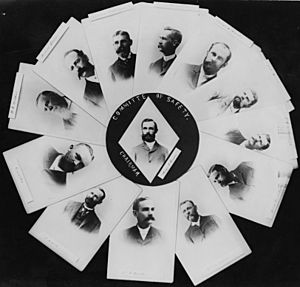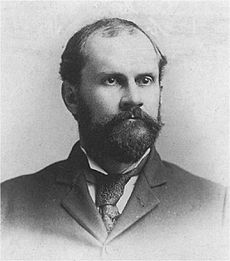Committee of Safety (Hawaii) facts for kids

The Committee of Safety
|
|
| Formation | 1887 |
|---|---|
| Dissolved | 1893 (succeeded by Provisional Government) |
| Type | Secret society |
| Purpose | Overthrow of the government of Hawaii, annexation by the United States |
| Location |
|
|
Membership
|
Elite business and political leaders |
|
Official language
|
English |
|
Unofficial leader
|
Lorrin A. Thurston |
|
Main organ
|
Committee of Thirteen, Committee of Safety |
| Affiliations | Honolulu Rifles |

The Committee of Safety was a group of 13 people. It was also known as the Citizen's Committee of Public Safety. Most members were Hawaiian citizens of American background. Some were American citizens or foreign residents living in the Kingdom of Hawaiʻi. This group planned and carried out the overthrow of the Kingdom of Hawaiʻi on January 17, 1893.
Their main goal was for Hawaiʻi to become part of the United States. They wanted the U.S. to annex Hawaiʻi. A new government, the Republic of Hawaiʻi, was formed. However, U.S. President Grover Cleveland did not support this right away. Hawaiʻi did not become a U.S. Territory until 1898.
Contents
How the Committee Started
The Committee of Safety grew from an earlier group called the "Committee of Nine." This group formed in 1883. Its goal was to lead the Independent Party in Hawaii's elections. Most members of this group were loyal to the "Missionary Party." They shared similar ideas about society and business.
In the 1884 elections, the Independent Party won 13 seats. They were the smaller party in the legislature. For the 1886 elections, the group met again. This time, they called themselves the "Committee of Thirteen" because some members had changed. They hoped to make the Independent Party the main party. But they only won ten seats, losing three.
The Hawaiian League
In January 1887, the Committee of Thirteen created a secret society called the Hawaiian League. They did not keep official records. However, Lorrin A. Thurston wrote down the group's rules. He was the grandson of American missionaries. The group was led by lawyers and businessmen. Most were naturalized U.S. citizens living in Hawaii.
More people joined the League over time. This included some German and British citizens. A few people of mixed Hawaiian and foreign heritage also joined. The politicians changed their party name from "Missionary" to "Reform." But many of them wanted Hawaii to join the United States, not just change the monarchy. This is why the Hawaiian League was also called the Annexation Club.
The Hawaiian League gained control of a group called the Honolulu Rifles. This was a group of about 200 armed local men. They were not native Hawaiians. They were led by Volney V. Ashford, who strongly supported annexation. In June 1887, the Hawaiian League used the Rifles to force King Kalākaua to sign the Bayonet Constitution. This new constitution greatly limited the King's power.
When Queen Liliʻuokalani became ruler in 1891, she tried to get back the power of the throne. This made the Hawaiian League decide to act again.
The Overthrow
The main reason for the overthrow was Queen Liliʻuokalani's plan. She wanted to create a new constitution. This would have given more power back to the monarch. It would have reduced the power of the legislature. In the legislature, American and European business leaders had a lot of power. This situation was a direct result of the 1887 constitution. The group's goals were to remove the Queen, end the monarchy, and have Hawaii join the United States.
On January 16, the Marshal of the Kingdom, Charles B. Wilson, learned about the planned overthrow. Wilson asked for permission to arrest the 13 members of the Committee of Safety. He also wanted to declare martial law (military rule). But these requests were denied many times. The Committee members had strong connections with the U.S. Government Minister, John L. Stevens. Officials feared that arrests would make the situation worse.
After talks with Thurston failed, Wilson gathered his men. Wilson and Captain Samuel Nowlein had 496 men ready to protect the Queen.
The revolution began on January 17. A policeman was shot and wounded. He was trying to stop a wagon carrying weapons to the Honolulu Rifles. The Committee of Safety worried this shooting would bring government forces against them. The Rifles took over Ali'iolani Hale, a building across from ʻIolani Palace. They waited for the Queen's response.
During these events, the Committee of Safety said they were worried about American residents in Honolulu. U.S. Minister John L. Stevens was told about these supposed threats. He agreed to their request. He called for U.S. Marines from the USS Boston and U.S. sailors to come ashore. On the afternoon of January 16, 162 armed sailors and marines landed. They took positions at the U.S. Legation, Consulate, and Arion Hall.
These U.S. forces did not enter the Palace grounds. They did not take over any buildings. They never fired a shot. But their presence made the Queen's defenders feel intimidated. Historian William Russ said that the order to prevent fighting made it impossible for the monarchy to protect itself. The Queen wanted to avoid any fighting and loss of life for her people. After thinking it over, and with advice from friends, the Queen ordered her forces to surrender. The Honolulu Rifles then took over government buildings. They disarmed the Royal Guard. They declared a Provisional Government.
The Committee of Safety made an announcement. Its chairman, Henry E. Cooper, read it aloud on January 17. A large crowd was gathered in front of ʻIolani Palace. The announcement said:
- "First – The Hawaiian monarchy (king/queen rule) is now ended."
- "Second – A temporary government is now set up. It will manage public affairs and keep peace. It will exist until Hawaii can join the United States of America."

The Hawaiian League unofficially used the American Flag. They did this to show they wanted to join the U.S. Minister Stevens raised the flag over ʻIolani Palace on January 17, 1893. However, the flag was later taken down in April by James H. Blount. This was because it wrongly suggested that the U.S. had already taken control.
Members of the Committees

Committee of Nine
- Joseph B. Atherton
- William R. Castle
- Sanford B. Dole
- William W. Hall (1841–1910)
- James A. Hopper (1831–1900)
- Peter C. Jones
- Henry W. Mist (1833–1895)
- John H. Paty
- William O. Smith
Committee of Thirteen
- Joseph B. Atherton
- Jonathan Austin
- William H. Bailey
- William R. Castle
- Benjamin F. Dillingham
- Sanford B. Dole
- Henry F. Glade (1883–1894)
- William W. Hall
- Peter C. Jones
- Thomas May
- John H. Paty
- Lorrin A. Thurston
- George N. Wilcox
Committee of Safety
Six Hawaiian subjects, five American citizens, a German subject, and a British subject signed the January 16 letter:
Hawaiian Kingdom subjects:
- Crister Bolte, born in Germany, became a Hawaiian subject, member
- William Richards Castle, Hawaiian subject, born in Honolulu 1849, lawyer for King Kalākaua 1876, Hawaiian legislator 1878–88, member
- Chairman Henry Ernest Cooper, American citizen who arrived in 1890, resident of the Kingdom, named chairman January 14, 1893
- William Owen Smith, Hawaiian subject, born on Kauaʻi 1838 to American missionaries, member
- Lorrin A. Thurston, Hawaiian subject, born in Hawaii to American grandparents, member
- Henry Waterhouse, born in Tasmania, became a Hawaiian subject, came to Hawaiʻi 1851, member
- William C. Wilder, became a Hawaiian subject, brother of Samuel Gardner Wilder, member
Non-subject Members:
- Andrew Brown, Scottish, member
- John Emmeluth, American citizen, member
- Theodore F. Lansing, American citizen, member
- John A. McCandless, American citizen, member
- Frederick W. McChesney, American citizen, member
- Edward Suhr, German citizen, member
Others who helped in the overthrow:
- Charles L. Carter, American, became a Hawaiian subject, member, died during the 1895 counter-revolution
- Samuel Mills Damon, Hawaiian subject with American parents, vice president of Provisional Government
- Sanford B. Dole, Hawaiian subject with American parents, chosen to lead Provisional Government and Republic
- Peter Cushman Jones, American, became a Hawaiian subject, provisional government minister of finance
- James A. King, Scottish, named minister of interior
See also
- 1887 Constitution of the Kingdom of Hawaii
- Reform Party of the Hawaiian Kingdom
- Provisional Government of Hawaii
- Republic of Hawaii
- Territory of Hawai'i

